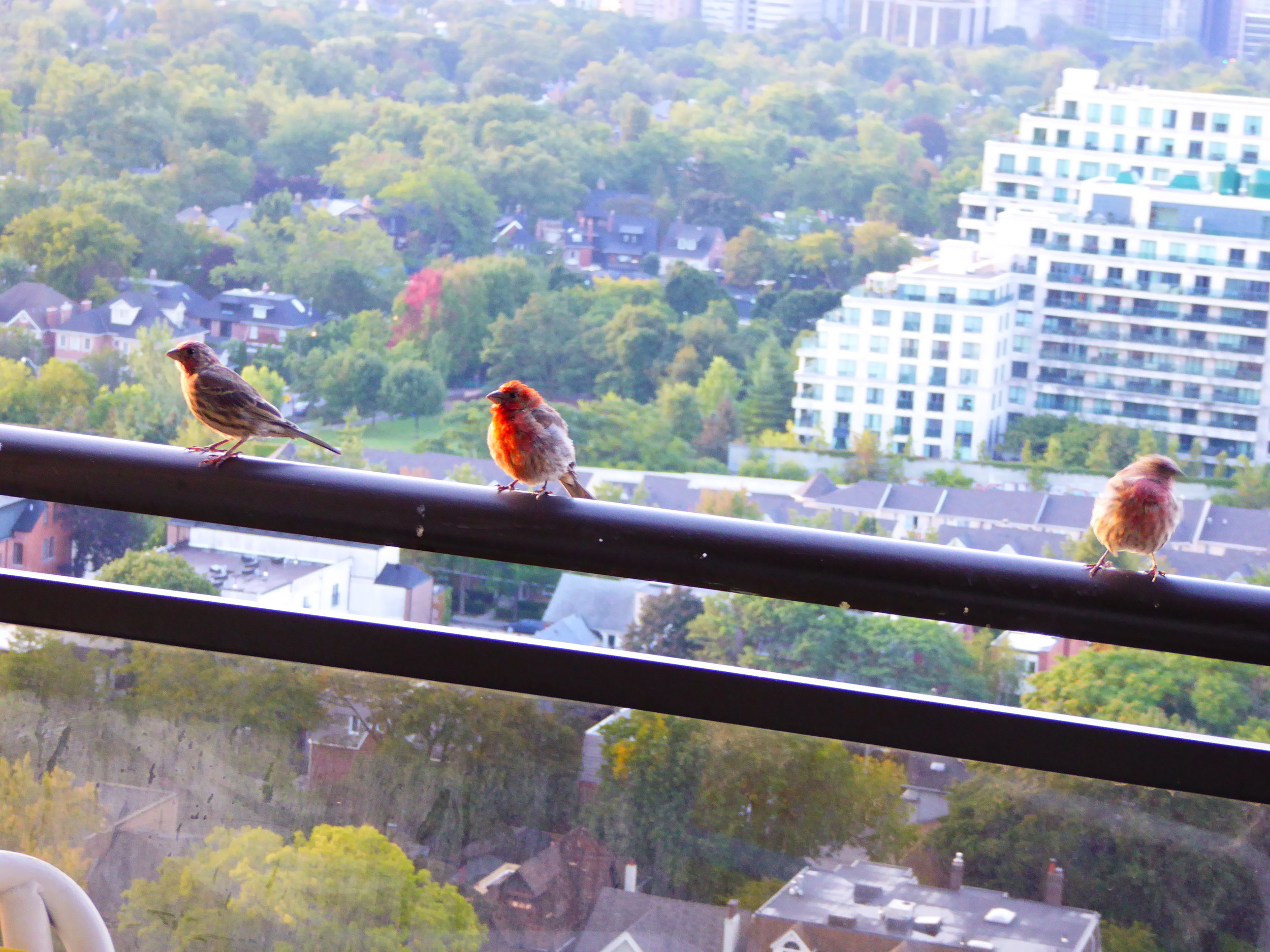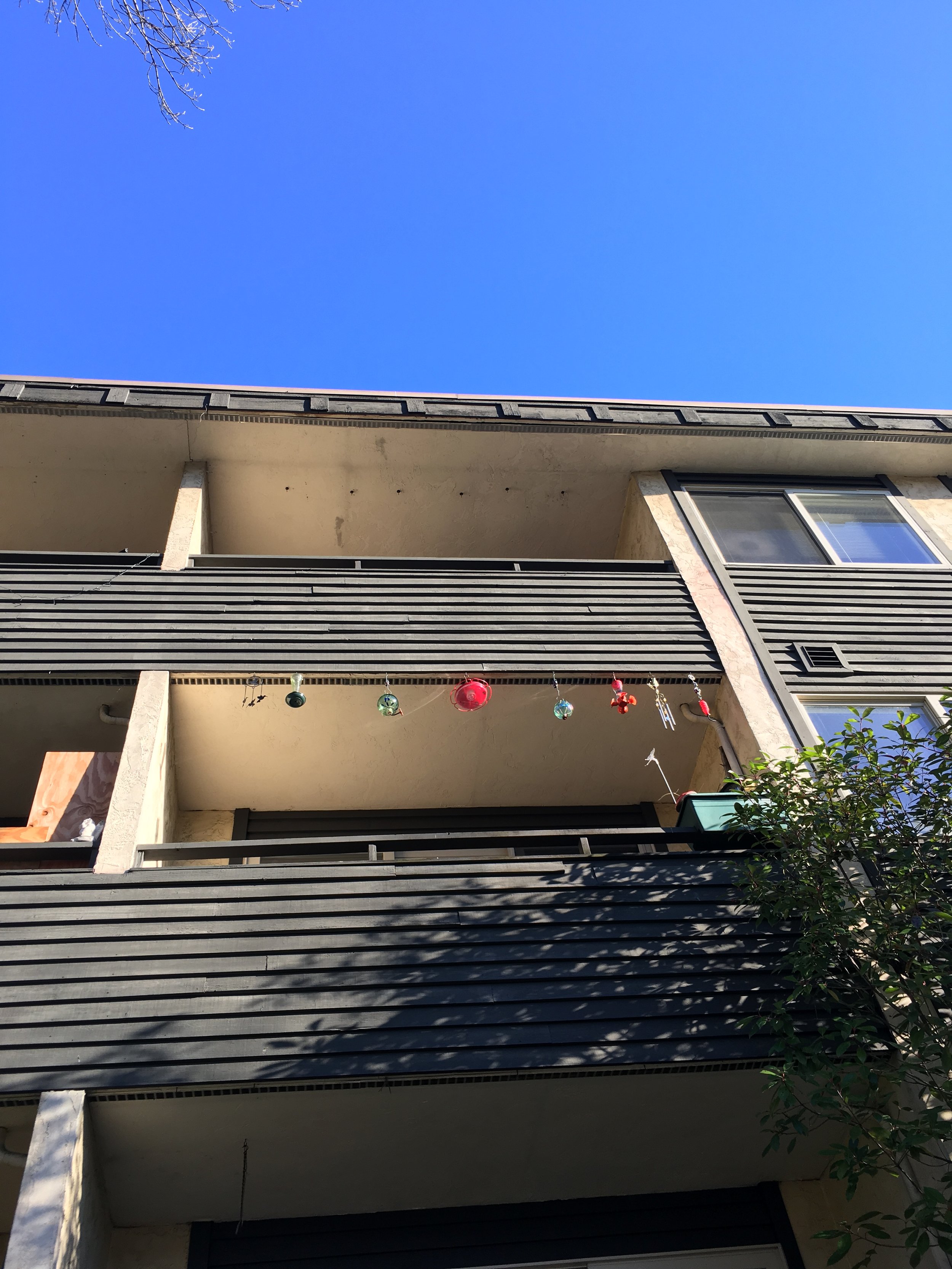Can you backyard bird from a high rise? The short answer is, YES. But do you want to watch gulls and Red-tailed hawks through the glass of your window, or attract smaller birds to your window or balcony like someone with an actual yard?
There is not a lot of information out there about how to set up a postage-stamp size bird attractant, be it a feeder, water or potted plant on high, let alone what birds might arrive as a result. Cornell offers this short how-to for attracting birds to a high rise but I found it lacking for HOW high. I’m wanting to know what birds will come if you put out something really high up?
Let’s start with feeders.
The journalist Emily Voigt wrote what is the most thorough account available by anyone trying to feed city birds from multiple stories up. She suggests that urban bird feeders are changing the course of evolution, from House Finch bill size in NYC to the over-wintering of Anna’s Hummingbirds in the Western US. She is speaking of feeders in general, but her personal experiment was from an apartment 25 stories above Greenwich Village.
Astonishingly, she did it with a feeder similar to this one. While her windows open (eek!), they don’t exactly accommodate a traditional feeder, nor should they. Her feeder sat on the inside window ledge, reducing any danger of it plummeting to the streets below.
Go and follow the link to see what I’m talking about, then click on Voigt’s article and watch the video of the House finches she attracted. From a gazillion stories up. Gulp.
House Finch at 21 stories up, with the Toronto CN Tower in the distance. Courtesy of Lynn P.
Then there is Lynn P. of Toronto, Canada who lives on the 21st floor of her apartment building and has hosted birds to her seed feeders for 20 years. Birds found her before her effort to attract them: “House finches landed on the railing of the deck the day I moved in so I quickly put up a feeder and they have been here ever since,” she says.
Lynn has the advantage of a building with no stated rules about feeding wildlife. She puts out hulled sunflower seeds and water and watches the finches feed each other, and occasionally take an interest in her, their host. One finch even followed her movement inside for a week then ventured in through the sliding door for a short visit.
Brave house finch visiting inside Lynn P’s Toronto apartment. Courtesy Lynn P.
OK, so what has Seattle got to show for itself along these lines? This used to be a city of single family homes and 5 story apartment buildings but in recent years the skyline has exploded with shiny mixed use behemoths around the city center.
So I trot around, looking up for signs of urban bird feeders on apartment buildings. Most of what I spot are 10 stories or lower, and most of them are hummingbird feeders.
On the streets of First Hill, Seattle. Teeny tiny red dot on the 10th floor balcony is a hummingbird feeder!
This was consistent with the comments I got when I appealed for sources for this topic on Facebook. ”I got hummingbirds on the 16th floor, that’s it…I wouldn’t recommend anyone who wants to watch birds move to a high rise unless they are OK with just hummingbirds,” said one respondent from the Western Washington Birders group.
Still more hummingbirds, though this time without a feeder: Another apartment dweller shared that she has had Anna's hummingbirds come to a small potted fuchsia on the fourth floor of two different apartment buildings, living as she does in places that prohibit feeders.
Second floor apartment balcony in Lake City, Seattle.
Yup, there is that reality of apartment or condo living: Building rules. “Many buildings (have) concerns about bird strike on windows, seed mess attracting rodents, and the mess caused by concentrated bird droppings,” said a third respondent. “ It would be awkward to have a how-to article only for readers to learn they can’t and, possibly, incur fines for doing so.”
The takeaway?
Stick to feeders with low waste contents such as hulled sunflower seeds or nectar if your building permits.
Place feeder either ON window (like a suction feeder) or as far from window as allowable, to prevent bird strikes.
Expect (or hope for!) house finches and hummingbirds.
Next up, a container garden.
“Container garden!” says Julie Zickefoose, author of the invaluable resource, Natural Gardening for Birds: Creating a Bird Friendly Habitat in Your Backyard, which features her illustrations of plants and the birds they attract. She’s chatting with me on the phone from her rural Ohio home, looking out at actual countryside not urban blight, but she’s got a fantastic imagination.
“There is no reason you can’t haul a container and compost to any floor of a high rise apartment, or improve a place with difficult planting conditions.” She says. She applies container gardening to her own property in order to circumvent a constant battle with encroaching grass.
Your balcony container garden might provide food for passing birds, and it also might lend cover or nesting opportunity. “If you group containers together in a place not near where you’re sitting, you might provide a private place for nesting,” says my mother, Noel Angell. She’s hosted Bewicks wrens near her front door, nesting in one of the holes in a ceramic tiered succulent container.
And turns out your containers don’t even have to have plants in them! If your empty plant box is big enough you might host nesting peregrine falcons, like this Chicago resident. OK, that’s not exactly a sure thing, but WOW, wouldn’t that be cool? See what can happen if you put some green on your balcony or window?
The takeaway?
Plant a container or window box with something hardy, native to your zip code, and flower/berry/seed bearing.
Group containers together for a “garden like” impact.
Aaaand finally, windows…
I can’t write about high rise bird gardens without talking about windows. I hate to tell you this but windows are bird killers.
Building windows kill one billion birds every year in the U.S. That’s all buildings, not just high rises. Basically, if your office building, family cabin, single family home has windows, those windows are in the path of a bird flying as speed that will impact and break its neck or die later from internal injuries.
Clearly it’s possible to attract birds to your home without killing them, as demonstrated in this post, so follow the lead of the women quoted here and the advice about feeder placement.
You might even go a step further and follow the advice of another woman featured on my site, Heidi Trudell. She recommends window treatments for window strike abatement if you discover this is an issue for you. It’s the responsible thing to do if you attract birds to your high rise. You wouldn’t want to kill your guest inadvertently.
On that high note, I’ll end this by welcoming your stories about high rise birding! Please comment or send me an email, I’d love more content and photos on this topic. And if you like reading about birding in the city, read two interviews I did, one with New York City birder and podcaster Georgia Silvera Seamans, the other with Londoner David Lindo on his 2018 book, How to be an Urban Birder. Ideas galore!
*This post was updated 8/14/2022.




